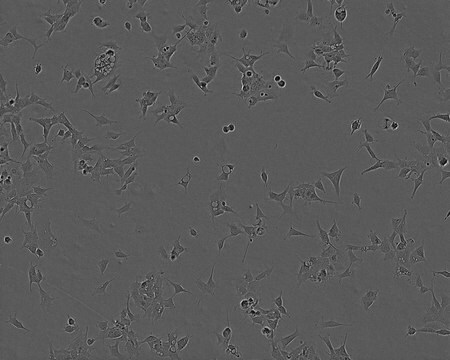C6 Cell Line from rat
92090409, rat nerve (glial tumor), Neuronal
Synonym(s):
C-6 Cells, RGC-6 Cells
Sign Into View Organizational & Contract Pricing
All Photos(1)
About This Item
UNSPSC Code:
41106514
Recommended Products
product name
C6 Cell Line from rat, 92090409
biological source
rat nerve (glial tumor)
description
Rat glial tumor
growth mode
Adherent
karyotype
2n = 42
morphology
Neuronal
products
S-100 protein, somatotrophin
receptors
Not specified
technique(s)
cell culture | mammalian: suitable
relevant disease(s)
cancer
shipped in
dry ice
storage temp.
−196°C
Cell Line Origin
Rat glial tumour
Cell Line Description
Derived from a rat glial tumour induced by N-nitrosomethylurea. The cells produce S-100 protein which is found in the neural tissue of vertebrates and has been found in brain tumours. Synthesis of S-100 increases 10 fold as cells reach confluency.
Application
C6 cell line has been used to study the ability of 2-(2,4-dihydroxyphenyl)thieno-1,3-thiazin-4-one (BChTT) to inhibit cancer cell proliferation and identify mechanisms involved in its actions. It has also been used to study the cytotoxic and antioxidant properties of supercritical CO2 extract (SCE) of old man′s beard (Usnea barbata).
C6 cells are reported to produce elevated levels of glyceryl phosphate dehydrogenase activity in response to glucocorticoids
Culture Medium
Ham′s F12 + 2mM Glutamine + 10% Foetal Bovine Serum (FBS).
Subculture Routine
Split sub-confluent cultures (70-80%) 1:3 to 1:6 i.e. seeding at 1-3x100,000 cells/cm2 using 0.25% trypsin or trypsin/EDTA; 5% CO2; 37°C.
Other Notes
Additional freight & handling charges may be applicable for Asia-Pacific shipments. Please check with your local Customer Service representative for more information.
Certificates of Analysis (COA)
Search for Certificates of Analysis (COA) by entering the products Lot/Batch Number. Lot and Batch Numbers can be found on a product’s label following the words ‘Lot’ or ‘Batch’.
Already Own This Product?
Find documentation for the products that you have recently purchased in the Document Library.
Our team of scientists has experience in all areas of research including Life Science, Material Science, Chemical Synthesis, Chromatography, Analytical and many others.
Contact Technical Service
